When selecting one of the best lighting choices on your pet reptiles and amphibians, it could actually get complicated. There are such a lot of completely different wattages, bulb sorts, and functionalities, to not point out lighting rigs and {hardware}. However in relation to UVB mild particularly, you would possibly marvel why you want it in case your lizard is proud of a powerful basking bulb.
An In-Depth Look At UV Gentle And Its Correct Use With Reptiles
Reptile Lighting Info
Rethinking Reptile Lighting
Captive reptiles want each basking and UVB mild. Basking bulbs don’t present UVB. This naturally comes from the solar, which is why pet reptiles love sunny rooms and attending to discover outdoors. Sadly, UVB can’t go by means of glass. You and your iguana would possibly really feel heat on a sunny windowsill, however they gained’t get their much-needed UVB this fashion. When pet reptiles reside indoors, they want a gentle supply of each UVA and UVB mild.
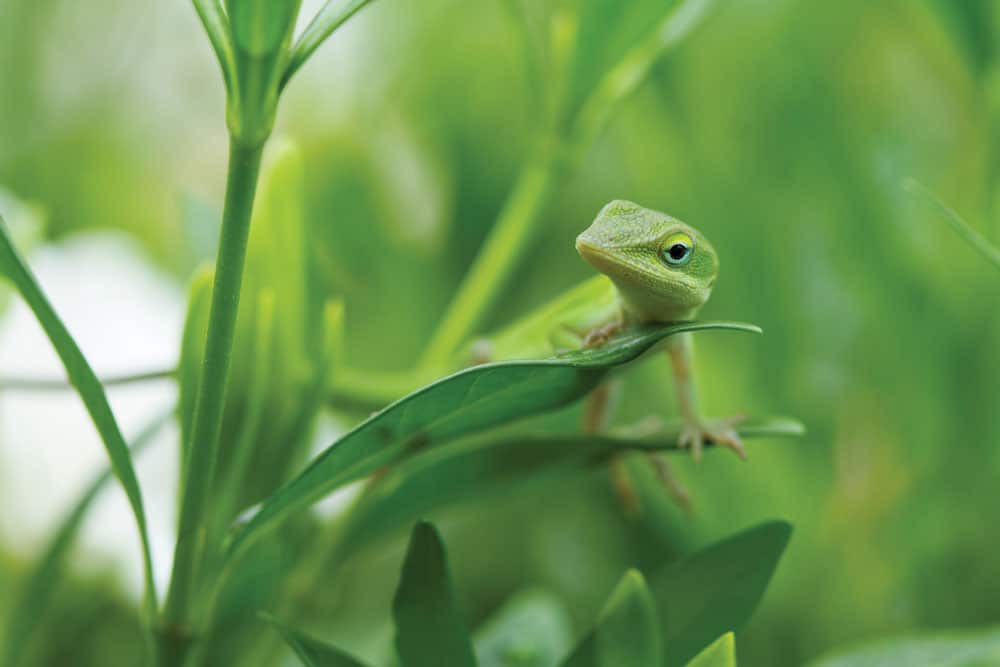

Inexperienced anoles are thought of partial solar seekers, occasional baskers. They’re a Zone 2 reptile. Photograph by Ami Atari/Shutterstock
UVB mild isn’t seen to reptiles, however it permits the synthesis of an important nutrient, vitamin D3, within the pores and skin. UVB and heat, collectively, remodel a pure ldl cholesterol into this vitamin, which is utilized by each organ within the physique for various capabilities. An important one is enabling the intestine to take up calcium from the meals – calcium is important for wholesome bones and for all muscle mass and nerves to operate correctly. Vitamin D additionally helps the immune system, the kidneys, the digestive system, the mind, progress, and copy. Reptile multivitamins containing D3 may also help, however they aren’t an alternative to species-appropriate UVB lighting.
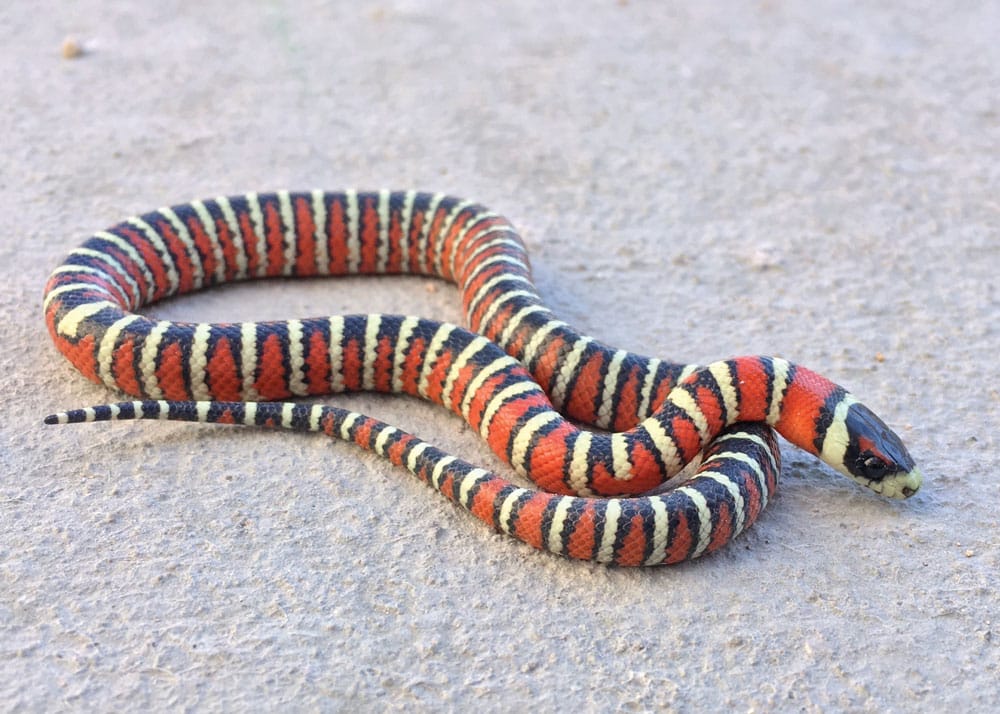

Sonoran mountain kingsnake. It’s a Zone 2 reptile. Photograph by Matt Jepson/Shutterstock
Metabolic Bone Illness (MBD) is the commonest illness of reptiles deriving from dietary and housing failure. With out appropriate UVB lighting, applicable heating, and a balanced weight loss plan, pet reptiles can turn out to be malnourished and develop debilitating sicknesses that lower their lives brief. MBD is one such situation, most frequently the results of vitamin D3 deficiency inflicting insufficient uptake of calcium from the weight loss plan. That is simply prevented by guaranteeing your reptile has the precise UVB lighting and heating for the species and an sufficient provide of calcium within the weight loss plan.
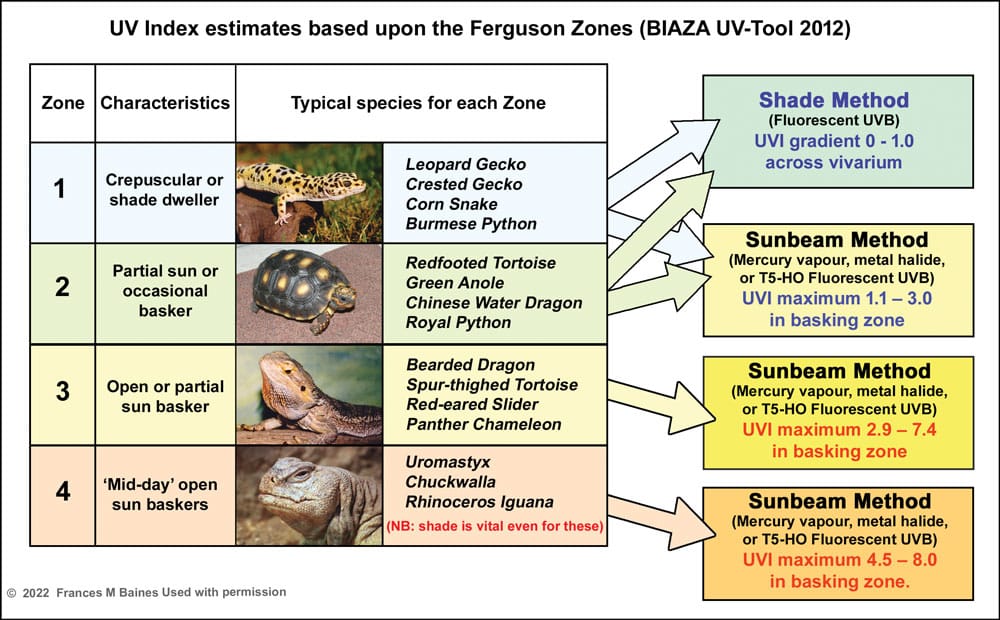

Ferguson Zones revised 2022. Frances M. Baines used with permission.
Reptiles can see UVA mild, they usually want it identical to UVB. UVA is a “color” to them. This UVA-color is commonly of their pores and skin patterns and markings, serving to them acknowledge one another as female and male; many meals additionally replicate UVA shade, so it could assist stimulate a feeding response and different behaviors. Like UVB mild, UVA is a part of daylight however can also be emitted by all UVB lamps bought for reptiles. It’s additionally current in small quantities in extraordinary incandescent lamps, like halogens, used as basking lamps, however none is emitted by “white” LEDs even when they’re labeled “full spectrum.”
In order for you your scaly companion to have a protracted, comfortable, and wholesome life with you, UVB lighting can’t be uncared for.
How UVB is Totally different from Basking Lights
Basking bulbs are halogen bulbs or different incandescent lamps akin to older-style reflector bulbs, they usually emit warmth (seen mild and short-wavelength infrared, as in daylight) primarily based on their wattage, width of beam, and proximity to the basking space. Adjustable clamp lamps and stands can direct the place the sunshine goes when the bulb is in a dome reflector, however some enclosures have built-in sockets or fixtures that simply undertaking the sunshine downwards.
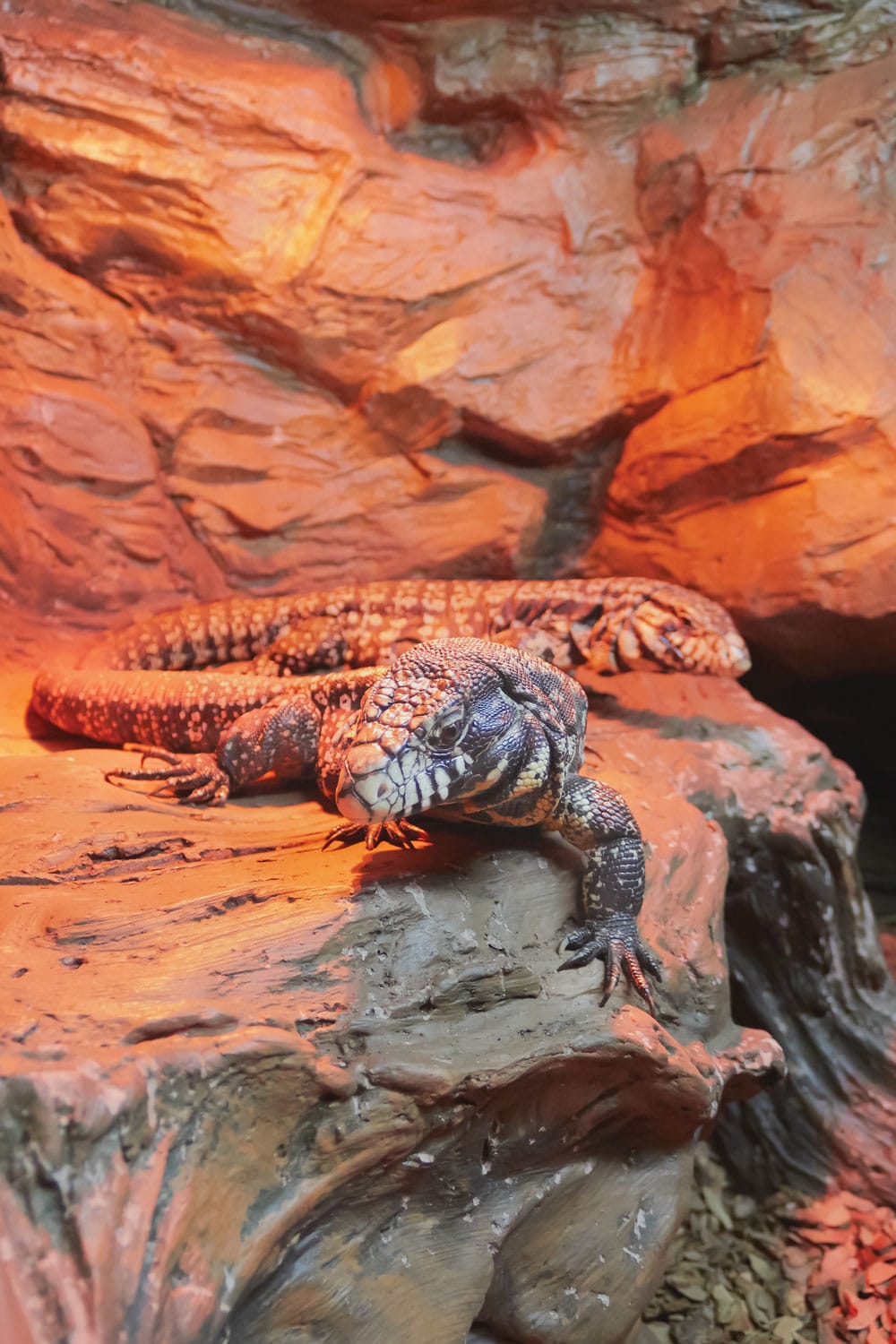

The black and white tegu (Tupinambis merianae) is a Zone 3 reptile, a partial or open solar basker. Photograph by BSG_1974/Shuttestock
As a result of the resultant basking temperature and gradient range primarily based on the enclosure’s measurement and general setup, a spot-check thermometer or “temperature gun” may also help you identify in case your basking bulb wants roughly wattage, or a wider beam, to regulate the temperature. The basking zone should all the time be at the least as giant as the entire physique of the reptile when basking underneath it. Basking lamps might be managed by a dimming thermostat.
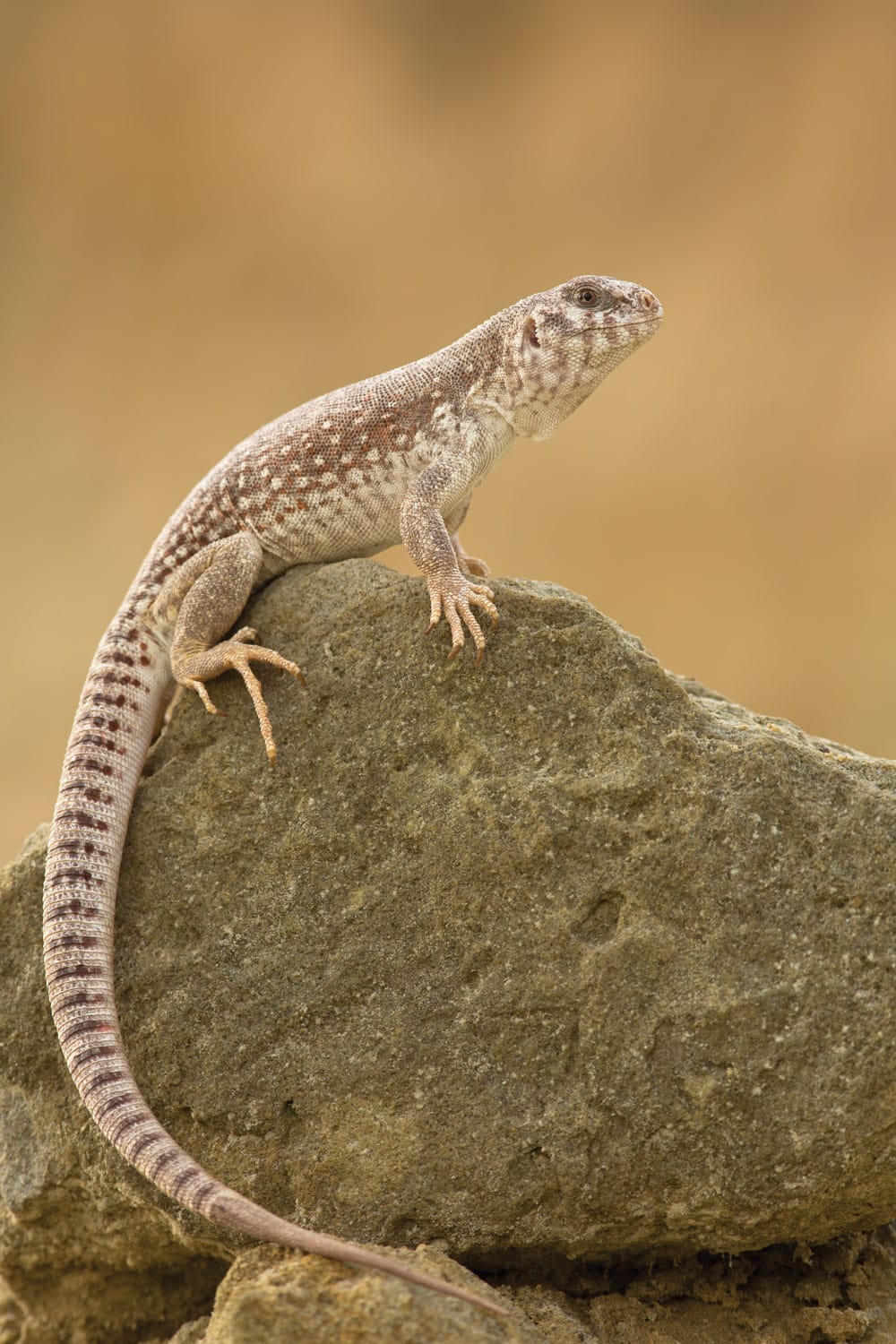

The desert iguana (Dipsosaurus dorsalis) is a Zone 3 reptile, a partial or open solar basker. Photograph by Milan Zygmunt/Shutterstock
The ambient (air) temperature will also be boosted by ceramic warmth emitters (CHE), particularly if the sunshine fixture is much from the ground in a tall enclosure. Nonetheless, CHE usually are not basking lamps. They solely emit long-wavelength infrared – the identical kind of warmth as BBQ coals, very completely different from daylight.
UVB fluorescent lamps serve a completely completely different objective. They don’t emit warmth and may’t be placed on a dimmer or thermostat. They’re graded in line with their depth.
All UVB lighting emits each UVB and UVA. It is because the phosphors utilized in fluorescent lamps emit all wavelengths from UVB by means of UVA to seen mild; and the mercury in mercury vapor lamps emits “spikes” of radiation within the UVB and UVA ranges. There are two primary sorts: compact lamps – both bar-shaped or coiled – that are formed like family “energy-saving” bulbs and screw into common lamp holders; and fluorescent tubes, both T8 (1” diameter) with low UVB output or the newer T5-HO tubes with excessive UVB output; fluorescent tubes slot in specially-designed fixtures with reflectors above them.
UVB mercury vapor bulbs are one other kind of lamp that has a screw becoming like common bulbs however can emit each warmth and UVB, and all emit UVA as effectively. Nonetheless, you might want to analysis whether or not they’re protected to make use of together with your reptile. The warmth or UVB could also be too intense for them. Utilizing completely different bulbs for warmth and for UV could make it simpler to customise to their wants, though desert lizards and different daytime baskers like Kimberley rock screens are inclined to do effectively with all-in-one mercury vapor bulbs in giant open-topped enclosures.
Making a “Patch of Sunlight”
Reptiles, being ectotherms (“cold-blooded”), have to heat up their our bodies day-after-day utilizing exterior warmth sources, they usually want to have the ability to modify their publicity to warmth always to maintain their physique temperature optimum for exercise and life. They do that by shifting in a temperature gradient, typically in search of to achieve warmth, typically retreating to cooler areas to lose warmth – that is “thermoregulation.” It’s usually supplied, in captivity, by making a “patch of sunlight” – a basking zone with larger warmth, mild, and UV, and a cool zone additional away, with a gradient from heat to chill, shiny to shaded, excessive UV to low UV, in between.
No matter kind of UVB lamp is used, its beam must mix with the beam from the basking lamp to create the “sunlight,” and so these lamps want positioning collectively. This basking zone have to be sufficiently big to heat and lightweight the entire physique of the occupant. “Spot” basking lamps are hardly ever applicable; search for sorts with large flood beams. Compact UVB fluorescent lamps solely present UVB over small areas, which is principally helpful in small terrariums for small reptiles. Fluorescent tubes have much better protection; T8 (1” thick) tubes present low-level UVB; T5-HO slim tubes in reflector fixtures can present sun-strength UVB over large areas.
LED UVB Lighting
Fashionable expertise might, within the close to future, deliver us LED lights that emit a full spectrum of sunshine with loads of UVB and UVA whereas saving on power payments. Choose legacy herpetoculture manufacturers have been experimenting with UVB-emitting LED lamps for reptiles already, however as but, there are nonetheless important questions on their long-term security. Their spectra are very completely different from daylight, and in concept, they might produce extreme quantities of vitamin D3 in reptile pores and skin, resulting in toxicity.
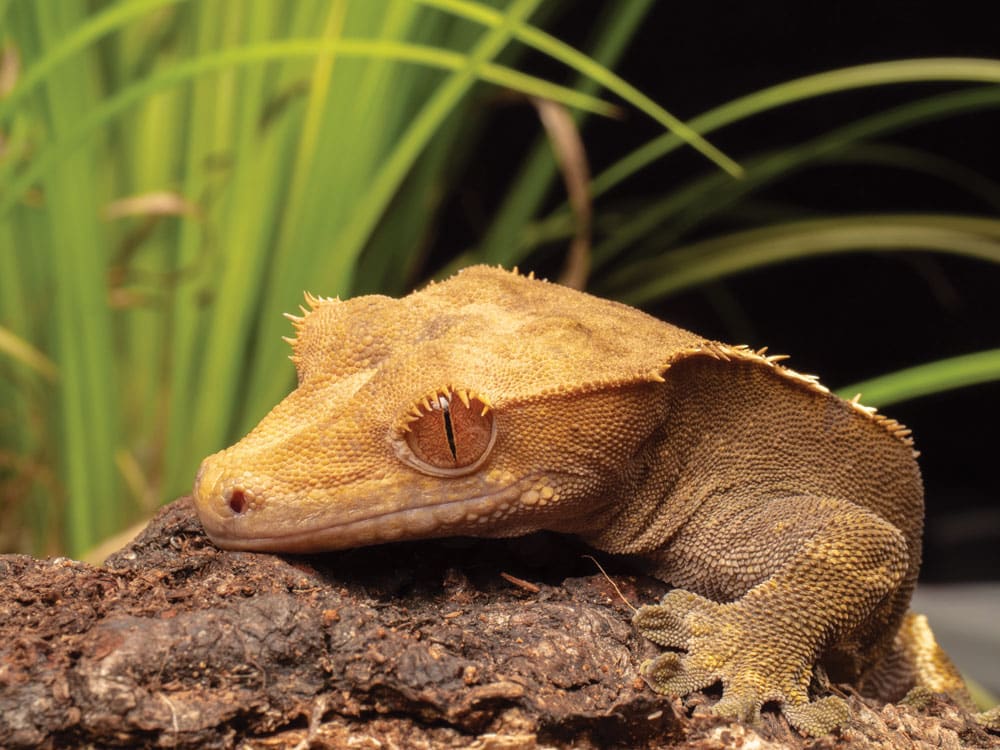

The crested gecko might solely want minimal UVB as it’s extra energetic at night time. It’s a Zone 1 reptile. Photograph by Christian Rogers Pictures/Shutterstock
Enterprising makers within the passion are additionally constructing LED options in each bulb and hood codecs, however as but, none have been examined for his or her security in long-term use. Some Chinese language manufacturers have already been discovered to emit dangerous ranges of UVB and even UVC; some have been withdrawn from sale. However, “white light” LEDs which don’t emit any UVA or UVB are a superb selection for enhancing seen mild in a vivarium. Whereas they carry a better price ticket than conventional bulbs, LED might be well worth the funding for its sustainability elements. LED items final just a few years, don’t require frequent bulb purchases, and the diodes are manufactured from sturdy supplies. LED lighting doesn’t produce warmth, however heat-emitting fashions fitted with infrared diodes might hit cabinets and reptile expos within the close to future with additional innovation.
UVB Ranges: The UV Index (UVI), Ferguson Zones, and the %UVB Quantity on the Field
That you must seek the advice of a care sheet on your reptile to learn the way a lot UVB it requires. Typically, so-called “desert” animals, like bearded dragons, which reside in open nation with loads of daylight, require excessive ranges of UVB. However, forest-dwelling and nocturnally-active reptiles, like crested geckos (usually referred to as “tropical” or “rainforest” species) might solely want minimal UVB.
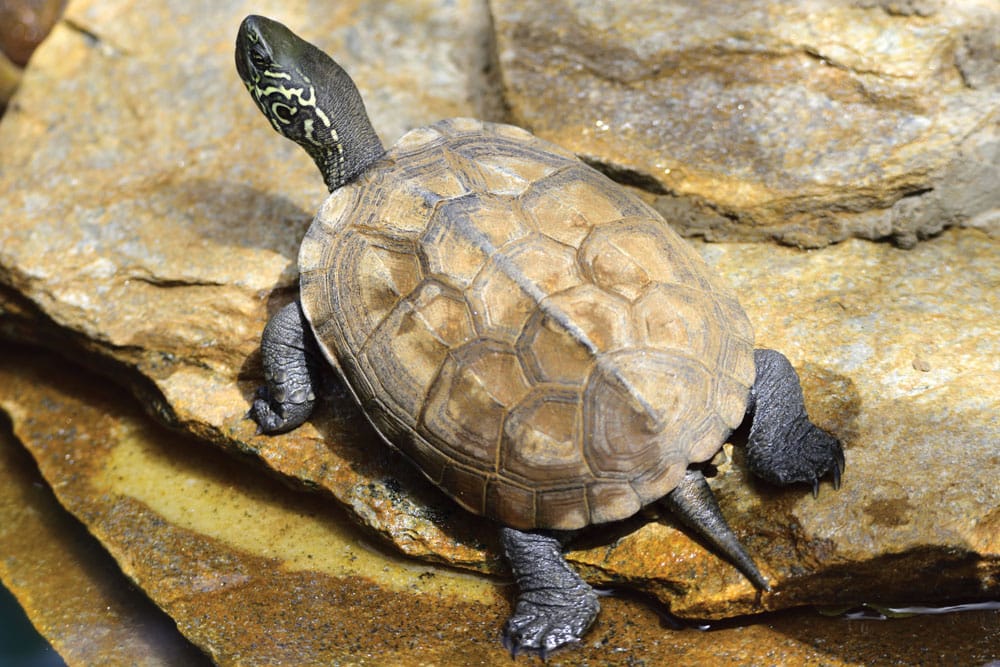

The Reeves turtle is a Zone 3 reptile. Photograph by Luciano de la Rosa/Shutterstock
However you is perhaps perplexed whenever you analysis care sheets and UV charts. What do these a number of numbers imply? How come they don’t align with the quantity on the field, akin to 6%, 12%, or 5.0 and 10.0, whenever you’re looking for UVB bulbs?
Are you acquainted with the UV Index (UVI) that seems in climate forecasts? We are sometimes informed to put on sunscreen if the UVI exceeds 3.0 (equal to morning daylight in summer time). The UV Index can also be an affordable indication of the power of the UVB from the solar – or a lamp – to synthesize vitamin D within the pores and skin. Totally different reptiles dwelling in several microhabitats expose themselves to ranges of UVI over the course of a day. So a sun-loving “desert” lizard would possibly take pleasure in daylight at UVI 4.0 – 4.5 after which transfer to shade with zero UVI; a shade-dwelling snake would possibly solely bask briefly at UVI 1.0 after which transfer to shade with zero UVI.


Ferguson Zones revised 2022. Frances M. Baines used with permission.
Ferguson Zones, a current invention named after herpetologist Dr. Gary Ferguson who devised them in 2010, simplify these micro ranges into 4 completely different Zones. The Zone ranges are primarily based on Dr. Ferguson’s research and observations of thermoregulatory behaviors in reptiles and the way they interacted with daylight whereas navigating their environments. The Ferguson Zone idea is that reptiles typical of every Zone needs to be supplied UV within the basking zone – their “sun patch” – as much as the utmost in that Zone vary after which a gradient to zero in full shade within the cooler elements of the vivarium.
What Concerning the Quantity on the Field?
Likelihood is that you just’ve seen UVB bulbs labeled with 5.0 or 10.0 at most chain pet shops. Compact and full-size UVB bulbs each have these grades. You’ll discover grades within the center, normally 6.5 or 7.5, at reptile expos and unbiased reptile outlets. These numbers would possibly sound alarming after studying the chart above.
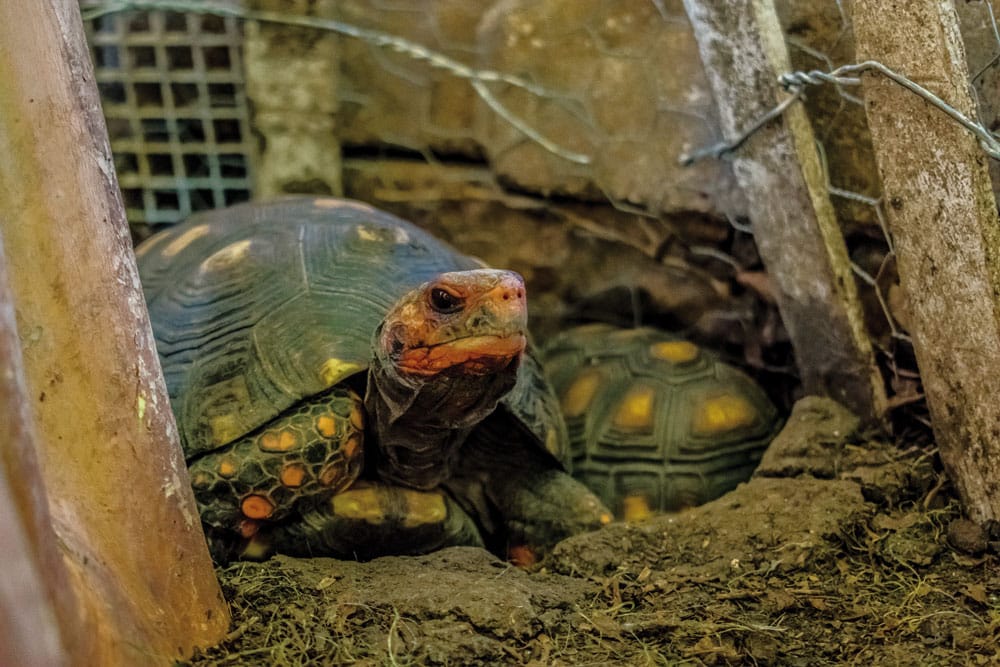

Purple-footed tortoise. It’s a Zone 2 reptile. Photograph by cooky_luvs/Shutterstock
The quantity on the field refers to how a lot of the bulb’s output is UVB. If it says 5.0, or 5%, then 5% of the bulb’s complete output is UVB whereas the remaining is devoted to UVA and visual mild. A ten.0 or 10% label signifies that 10% of the output is UVB, and so forth. The producer will normally embody a chart on the field or their web site explaining every of their merchandise’ Ferguson Zone and UVI equivalents as effectively. The upper the share of UVB, the “stronger” the lamp; what which means in observe is {that a} “stronger” lamp will produce your required UVI degree at a larger distance away from it than a “weaker” lamp from that very same product vary.
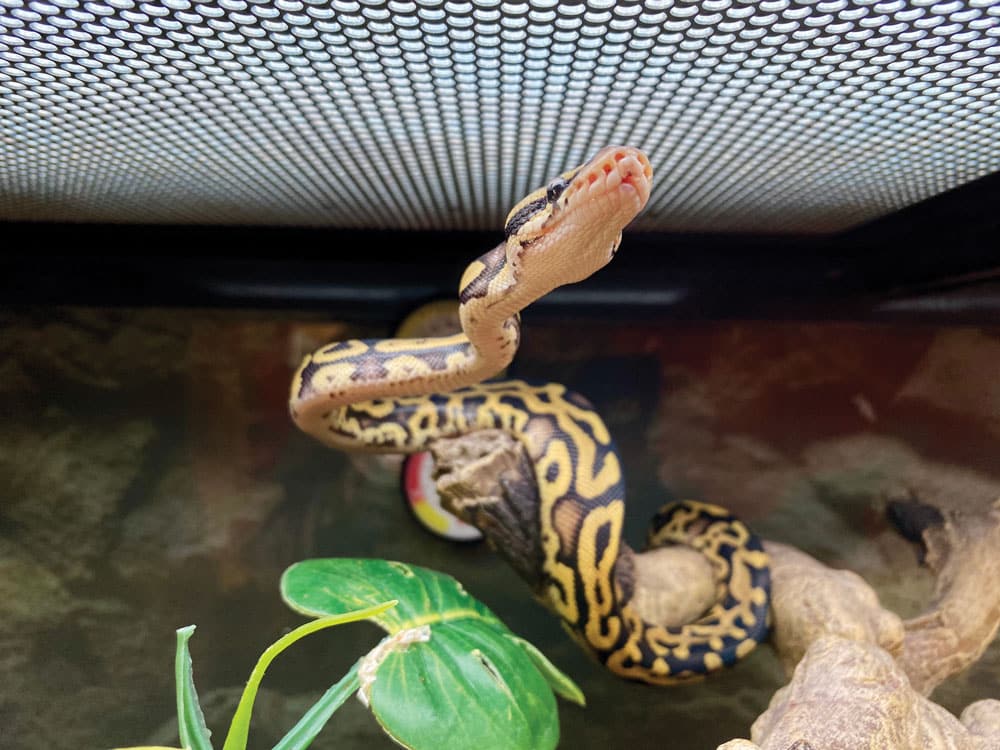

The ball python is a partial solar occasional basker. It’s a Zone 2 reptile. Photohobbiest/Shutterstock
When shopping for UVB bulbs, take a look at the scale of the bulb and the labeling (e.g. Ferguson Zone score, UVI, or %UVB) relatively than the wattage.
Wattage is a extra necessary measure for basking bulbs. Fluorescent UVB bulbs range extensively from little T5 8-watt fashions to 54-watt 44” T5-HO 10.0 tubes and all ranges between. Mercury vapor bulbs can be found as much as 160 watts. The %UVB can also be solely helpful up to some extent; ignore phrases like “desert” or “tropical.” What’s extra necessary is how shut your reptile will get to the lamp. Lamps with larger %UVB will doubtless provide the desired UVI at a larger distance however probably be unsafe with very excessive ranges at shut vary.
While you see charts with UVI and Ferguson rankings, keep in mind how shut your pet will get to the UVB mild supply. You’ll see that the nearer it will get to the lamp, the upper the UVI, in addition to the warmth and visual mild. The producer ought to have a chart for every lamp of their product line-up, detailing the ranges out there at completely different distances, so you’ll be able to determine which product will give an acceptable UVI over your animal when it’s basking underneath the lamp at your chosen distance.
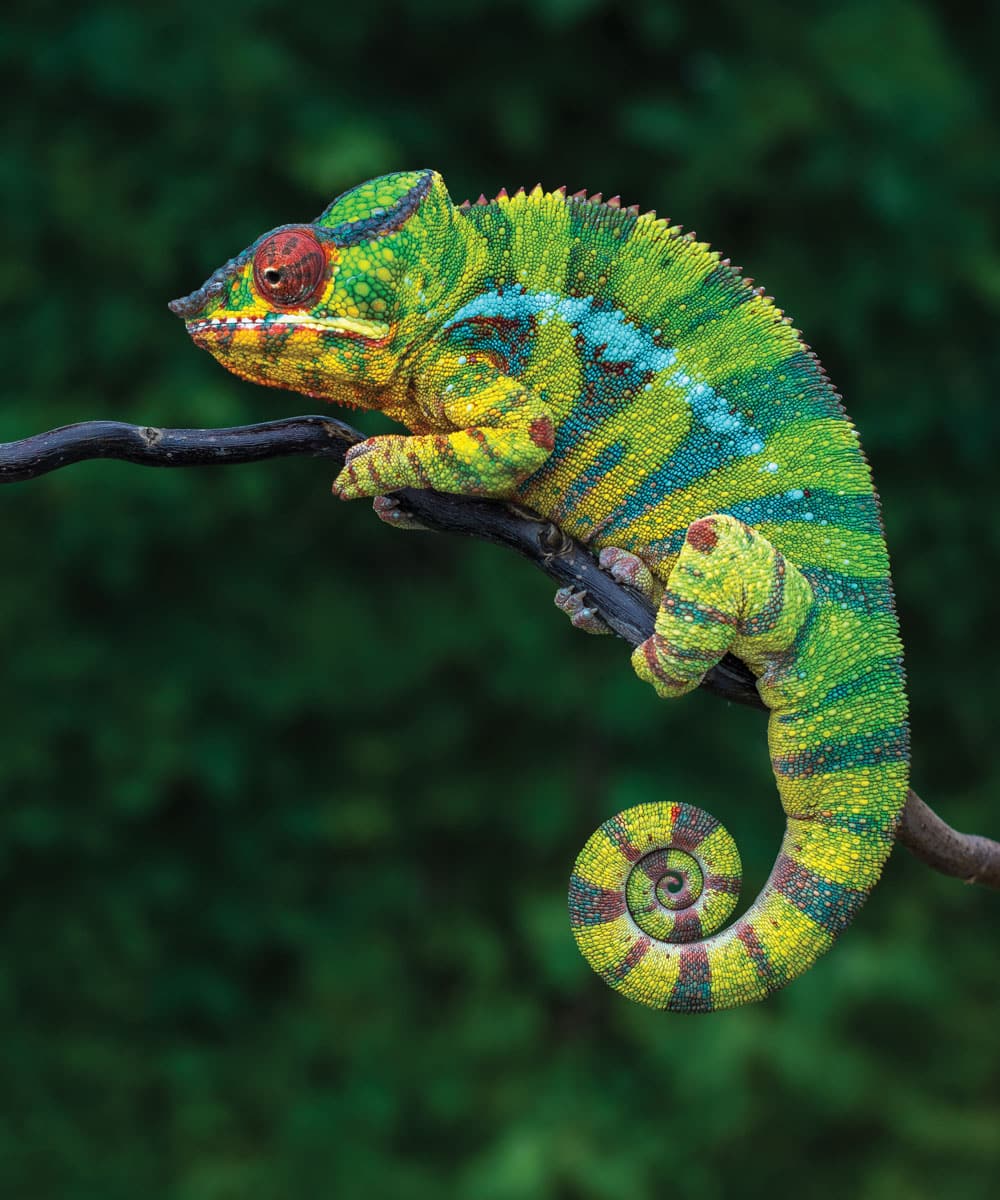

Panther chameleons are Zone 3 reptiles, a partial or open solar basker. Photograph by Jan Bures/Shutterstock
For instance, suppose you need your bearded dragon to have UVI 4.5, and he can be 10-12 inches beneath the lamp. A “desert” 12percentUVB Arcadia T5-HO 22” Equipment can be too sturdy – the right distance for UVI 4.5 can be 16 inches. However the “forest” 6percentUVB model is good, with UVI 4.6 at 10 inches distance.
Then you probably have a UV index meter, you’ll be able to merely use this to measure the UVI and place the lamp precisely whenever you arrange your vivarium. You additionally want to keep in mind that in case your lamps are positioned above a mesh display high, the mesh blocks a number of the mild and UV from getting by means of. Totally different producers make mesh with different-sized holes. For instance, ExoTerra mesh display lets by means of 65% of the UV, whereas Customized Reptile Habitats vivarium mesh lets by means of 77%. You’ll be able to calculate the UVI at any distance beneath a display utilizing that data and the producer’s chart for those who don’t have a UV index meter. Or you should use conversion charts; for instance, the Fb group Reptile Lighting has charts for T5-HO UVB tubes positioned over a variety of mesh manufacturers.
Why You Must Change UVB Bulbs Each Six to Twelve Months
Basking bulbs should be changed as soon as they burn out. The common incandescent lamp lasts 1,000 to 2,000 hours. That’s 3-6 months’ use at 10-12 hours per day. UVB bulbs should be modified each six to 12 months, even when the bulb hasn’t burnt out except you’ve a UV index meter and may see that the UVI studying continues to be inside the desired vary.
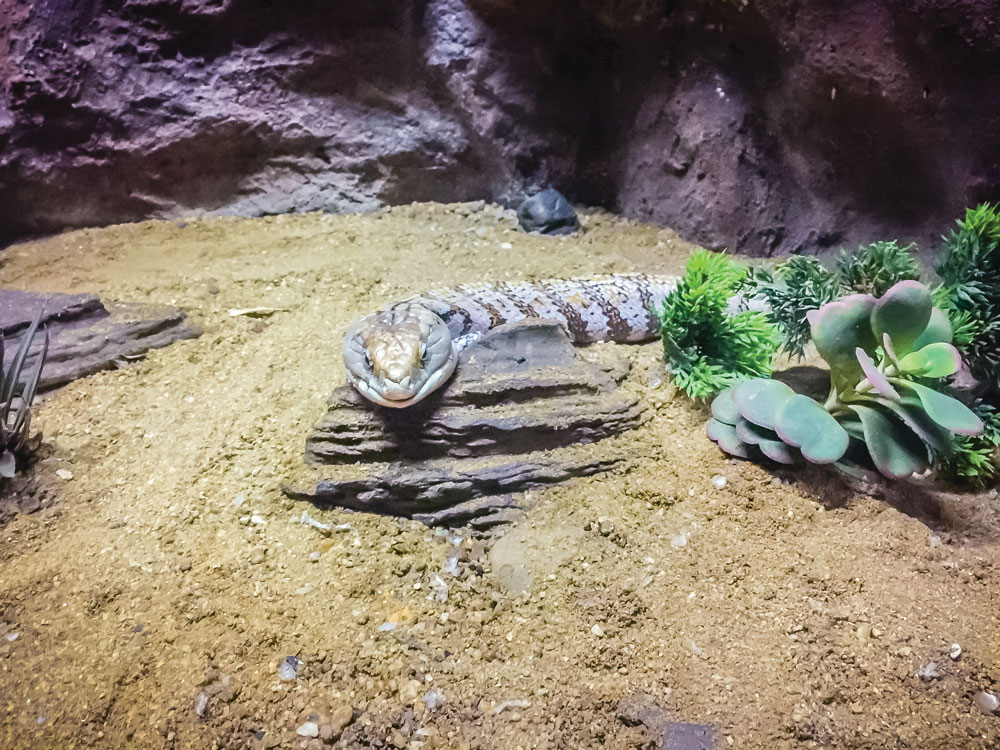

The blue-tongued skink is a Zone 3 reptile. Photograph by christopher pb/Shutterstock
Ths is as a result of the particular glass {that a} UVB tube or bulb is manufactured from slowly turns into much less clear to UV with use, however the seen mild will not be noticeably lessened in any respect. That is referred to as “solarisation.” Low cost manufacturers use glass that solarises quicker than that utilized by a number of the high manufacturers.
Select Excessive High quality UVB Lights
Typically, high-quality German-made tubes from Zoo Med and Arcadia solarise very slowly and usually hold a excessive output for at the least a full yr of use. Some cheaper lamps solarise a lot quicker, and a six-month alternative is commonly wanted. Compact lamps, which get a lot hotter owing to the shut proximity of every coil, additionally usually want changing after six months of use. As a result of UVB bulbs have such low wattage and different inside elements, it could actually appear misleading to throw out a seemingly operational bulb after six months.
Don’t fall for the glowing trickery: set reminders to alter the bulb each six or twelve months in line with the producer’s suggestions or use a UV index meter. Don’t depend on one of many color-changing UVB “detector cards” underneath the bulb to check if it’s nonetheless emitting UVB. The dye responds to UVA relatively than UVB, so you may get utterly false readings with these.
References and Additional Studying
Ferguson, G. W., Brinker, A. M., Gehrmann, W. H., Bucklin, S. E., Baines, F. M., & Mackin, S. J. (2010). Voluntary publicity of some western‐hemisphere snake and lizard species to ultraviolet‐B radiation within the area: how a lot ultraviolet‐B ought to a lizard or snake obtain in captivity?. Zoo biology, 29(3), 317-334.
Wacker, M. and Holick, M.F., 2013. Daylight and Vitamin D: A worldwide perspective for well being. Dermato-endocrinology, 5(1), pp.51-108.
Baines, F., Chattell, J., Dale, J., Garrick, D., Gill, I., Goetz, M., Skelton, T. and Swatman, M. (2016) How a lot UV-B does my reptile want? The UV-Instrument, a information to the choice of UV lighting for reptiles and amphibians in captivity. Journal of Zoo and Aquarium Analysis 4(1): 42 – 63
Baines, F. M. (2018) Lighting. In: Reptile Drugs and Surgical procedure in Scientific Observe. 1st Edn. Eds Doneley, B., Monks, D., Johnson, R. and Carmel, B. John Wiley & Sons Ltd. pp 75 – 90
Wunderlich, S., Griffiths, T., & Baines, F. (2023). UVB-emitting LEDs for reptile lighting: Figuring out the dangers of nonsolar UV spectra. Zoo Biology, 1–14. https://doi.org/10.1002/zoo.21806

